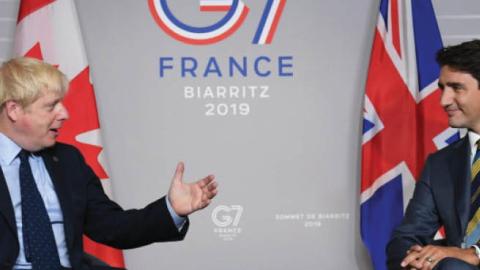Hong Kong, where the sun finally set on the British Empire in 1997, is now the fulcrum of London’s most fateful foreign-policy decisions since Brexit. But as Beijing tosses away its past commitments and imposes a draconian new security law on the territory, a geopolitically intriguing club of three is emerging, as Canada, Australia, and the United Kingdom support one another against Beijing.
This collaboration is an old idea, but it’s one with a surprising valence right now. Vague ideas for “CANZUK,” which included New Zealand with the three, as an economic community have gathered steam inside conservative parties in Canada, Australia, and Britain for some years. Like most analysts, I had dismissed these as imperial nostalgia projects that made little sense given the countries’ widely divergent economic interests and the reality that such collaborations were likely to do little to reinforce the rules-based global order.
Last year, the University of Cambridge historian Christopher J. Hill dismissed the Five Eyes intelligence alliance, which unites Australia, Canada, New Zealand, the U.K., and the United States, as a “sub-optimal relic of war-time days” that was “never going to be an ‘action organization’ in the sense of formulating joint foreign policies.” But events in China and Hong Kong should change everyone’s minds. Five Eyes has shown itself to be a crucial tool for coordinating a global response to China in the age of Chinese companies’ attempts to dominate 5G mobile communications networks. Canada, Australia, and Britain produced their own strong joint statement on Hong Kong before a follow-up added the United States.
This club of three—as a new C-3 grouping of Canada, Australia, and Britain—has legs. But the idea must be reclaimed from the nationalist right: Not only is deepening foreign-policy coordination among Ottawa, Canberra, and London increasingly attractive amid the accelerating decay of the American-led world order, but this grouping has shown itself over Hong Kong to be far more meaningful in world affairs than seemed possible. Instead of being backward-looking, this is a progressive cause—and a worthwhile one.
Canada, Australia, and Britain are all facing a moment of crisis in their foreign policies. Canada’s humiliating failure to make it onto the United Nations Security Council reflects that it can now be picked on by China, or even Saudi Arabia, as the United States weakens. Australia is faced with cyberattacks and growing Chinese pressure. Britain, now outside the European Union, has been repeatedly threatened by China over Hong Kong, Huawei, HSBC, and nuclear power plants. All three are struggling to make their voices heard in international politics, in the various G-groups, in global bodies, and in President Donald Trump’s Washington.
Not only are all three countries feeling increasingly lonely, but they are also threatened with real vulnerability if Trump wins again or a contested election plunges the United States into a protracted crisis this November. But that loneliness is not something that can be made up for by gravitating toward Brussels. Sadly, for all three, Germany and France are in a very different place from them on the authoritarian powers. Berlin, constrained by huge exports to China, wants to find a middle way between Washington and Beijing and is not ready to throw the EU into greater competition that could jeopardize critical trade for the sake of the interests of either Canada, Australia, or Britain. Paris, similarly, thinks differently on Russia. French President Emmanuel Macron’s emerging vision for a European Security Council or “Eurogroup”-style body including Russia, Turkey, and Britain is well outside the anti-authoritarian frame than Ottawa, Canberra, and London share. Macron, in fact, supported Trump in his desire to see Putin attend the now-canceled G-7 summit, something Canada and Britain opposed together—another example of this emerging entente.
The C-3 makes sense in this geopolitical breakdown. There is no pan-Western alliance like NATO on China for the three to fall back on. Nor, given Germany’s China strategy, is one likely to emerge. Moreover, Chinese and Russian aggression against the democracies is likely to grow, the United States might critically weaken, and the EU seems firmly set on pursuing a middle path. Instead of worrying about looking back to the past, leaders in Ottawa, Canberra, and London should embrace the idea and propose a significant deepening of their foreign-policy coordination. This is most definitely not about “getting the band back together, ” as one British Conservative member of Parliament greeted a trade talk announcement, but three middle powers building an anti-authoritarian group to resist great-power bullying in the 21st century.
The key to making this work is the right format. Right-wing “CANZUK” supporters have polluted the discourse with grandiose ideas involving secretariats or free movement that make working closer together look like a pipe dream. Successful foreign policy means coming down to earth, and the key to that is the right structure. The increasingly used E-3, a format uniting Britain, France, and Germany, offers a good model, but there is room to be more ambitious. A mini C-3 format would offer the best approach: a summit with follow-up that is both flexible and lightweight enough to get off the ground but with a permanent working group in foreign ministries advancing dossiers and initiatives. As the C-3 are all Commonwealth countries, summits could be timed to coincide with the biennial Commonwealth Heads of Government Meeting, where the leaders of Canada, Australia, and Britain regularly meet anyway.
As a central aim, this group should focus on automatically issuing joint statements on authoritarian rivals China and Russia. But it should also do more: Drawing both on Britain’s joint initiative with Canada to block Putin attending the G-7 and on Canada’s humiliating experience at the U.N., among this C-3’s first tasks should be to coordinate joint positions inside the U.N., G-7 and G-20. As far as major goals are concerned, this could include supporting any future attempts of Canada to win a seat on the U.N. Security Council and for Australia to formally join the G-7.
Meanwhile, the C-3 permanent working group could set to work in the format the other G-groups employ: seeking ground for joint initiatives that could be presented together at other forums. This could include promoting a “D-10” of the world’s leading democracies to work on the pooling of 5G resources or critical supply chains; a joint proposal for a “Global Kleptocracy Initiative ” to create common data tools, tracking teams, and payments databases to monitor illicit financial flows; or a push for a “Global Magnitsky Initiative” to automatically block human rights violators and freeze their accounts. This is not about replacing working with the EU or the United States but creating a group for Canada, Australia, and Britain to jointly present tougher anti-authoritarian packages to big powers than had they tried to individually present them alone. The C-3, like the E-3 to the EU, would be complementary to existing Euro-Atlantic bodies.
This C-3 could even grow into more sustained joint diplomacy toward Moscow and Beijing, including joint visits or ministerial staff accompanying a foreign secretary to indicate solidarity. In the event of Trump’s reelection, or a serious American crisis, a joined-up position on the United States could become necessary too. This could take the form of a C-3 joint position inside the Five Eyes security alliance to work to restrain an emboldened Trump administration. Taken together, these measures could add another, stronger front to those seeking to defend the liberal world order: in the interests of both a potential Biden administration and the European Union, alike. Moreover, the C-3 would fit well with the emerging vision of the Joe Biden camp for the United States to encourage different networks and groups of allies to do more together in partnership with Washington.
But as obvious as it may seem, strategically, much deeper cooperation between Britain, Canada, and Australia has an image problem. For many, it smacks too much of imperial nostalgia or conservative culture politics to seem like the future. For others, it feels too anchored on ethnic fraternity to feel right. This is why, in order to work, the idea needs to be decolonized.
First up, that means making it less British. It needs to be framed as not a Britain-led but a Britain-last initiative, with Canada and Australia taking the lead. As a formal name, the C-3 could even be called the “Canberra 3” instead of the “Club of 3.” The first summit, which could be virtual given the coronavirus pandemic, should certainly not be in London: a far better, more forward-looking location would be Vancouver. The C-3’s face should be Canadian Prime Minister Justin Trudeau and not his British counterpart, Boris Johnson.
Above all, the C-3 should explicitly reject a “kith and kin” basis. Excluding Prime Minister Jacinda Ardern’s New Zealand from the grouping will make it explicit this is not about any distasteful ideas of ethnic familiarity but geopolitics and values. Wellington is simply not in the same place as Ottawa, Canberra, or London when it comes to China. New Zealand sees itself as neutral in U.S.-China competition and has not signed either the U.K.-Australia-Canada statements over Hong Kong or those of the three with the United States. This grouping should be about mutual support when it comes to the superpowers: Those unwilling to offer it have no place in such an alignment.
But what about other middle powers? Why not include, say, Japan? This is where two critical principles of international politics come into play: Does your grouping have enough like-mindedness to be able to function and enough load-bearing capacity to get anything done? What Canada, Australia, and Britain are after is mutual geopolitical support; adding members that aren’t willing to offer that risks creating another talking shop like the Franco-German Alliance for Multilateralism. That group, which stretches from Chile to Kazakhstan, lacks the ability to agree on anything of substance—and the power to act on it.
The sad truth is there are simply not a lot of like-minded democracies to go around. Neither Japan, Chile, nor South Africa would sign on to strong enough statements or initiatives when it comes to Russia or China. European states that might be partners, like the Netherlands or Sweden, are engaged in a European China policy that is pulling in another direction, and they are highly unlikely to break ranks when the Franco-German force of gravity lies elsewhere. Prime Minister Narendra Modi’s India, which is not exactly like-minded, has a different history with Russia, sees itself as nonaligned, and has far more serious and potentially bloody problems with China that Canada, Australia, and Britain need some distance from. New Delhi is better engaged with through other ideas, like the more focused “D-10.” Many of the rest, like New Zealand, are simply too small and want to keep their heads down.
When it comes down to it, the three nations don’t actually have that much choice about whom they can deepen their partnerships with. Ottawa, Canberra, and London didn’t need each other in a U.S.-led world order or in a relatively benign world without authoritarian superpowers. But that system has decayed. Deep divisions, not just between the Europeans and Donald Trump, but with much of the U.S. national security establishment, are breaking up the old Washington-led ideological West. The common anti-authoritarian frame that once glued together Western foreign policy has come unstuck. Ottawa, Canberra, and London find themselves with very different strategic visions from Paris and Berlin about how to approach Moscow and Beijing. In this world, the C-3 is a liberal international, not a nationalist, cause. And the more of those that get off the ground, the better.
Read in Foreign Policy

















